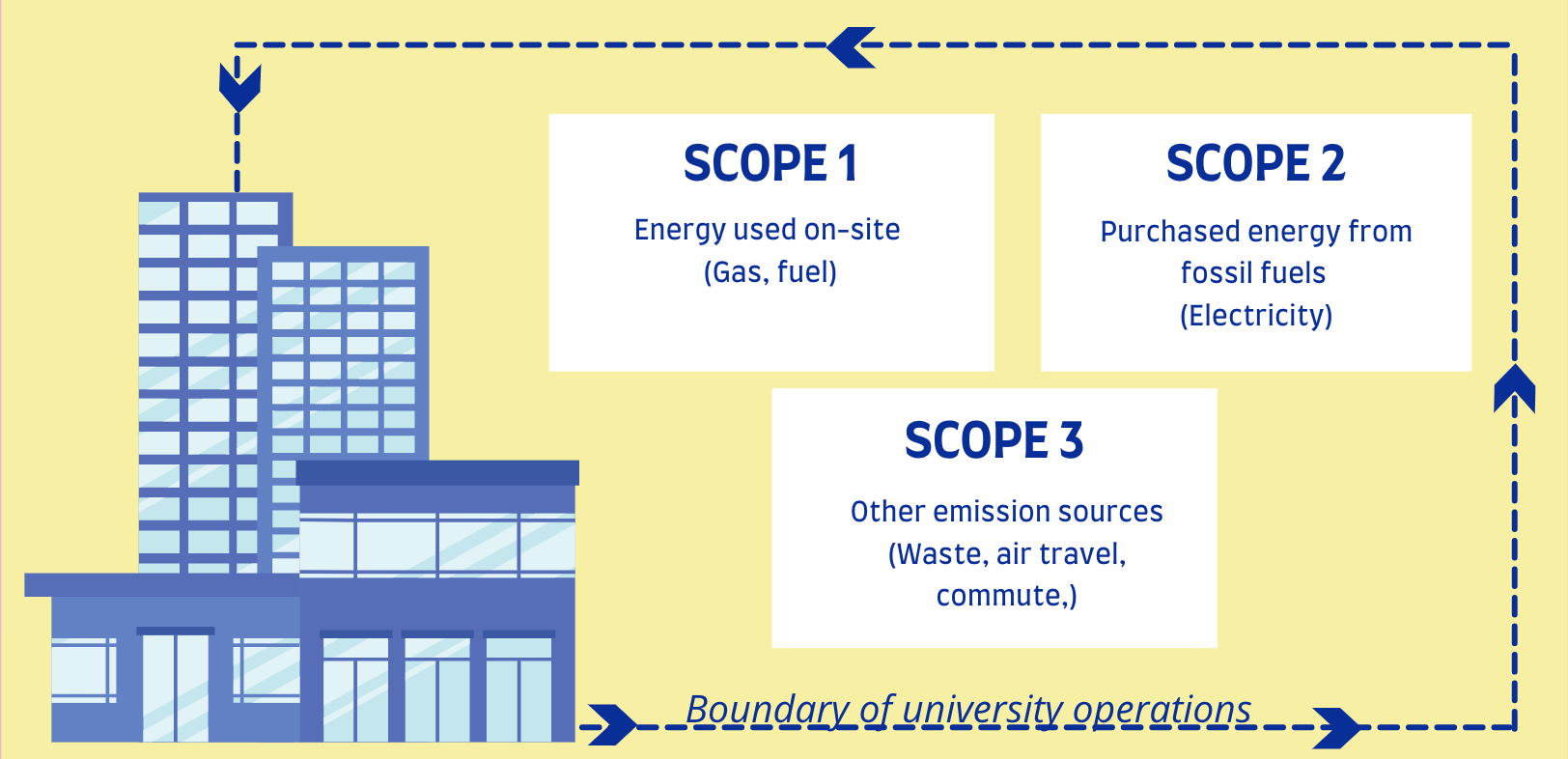Higher Education's role in mitigating climate change
Research
Back to the basics - What is the carbon footprint of a university and how do we reduce emissions?
Carbon emissions come from a number of greenhouse gas sources. Emissions from these sources are measured and then put into 'carbon equivalent emissions'.
Emissions sources fall into 3 categories or scopes. Scope 1 emissions occur on-site. For example, fuel in grounds-keeping vehicles is combusted on-site, so this is considered scope 1. Scope 2 emissions are combusted off-site but used by an organisation, electricity is the main contributor here (coal or gas is burnt elsewhere and then transmitted to a university). Finally, scope 3 emissions involve other organisations but still a result of the university's operations - like flights, staff travel in vehicles to work, and waste.
The first step when undertaking a carbon footprint is to draw a boundary around an organisation's operations and figure out what is in, and out, of operational control. You then measure the emissions within this boundary over a 12 month period.

How well are universities accounting for emissions?
Geographically it varies, according to a recent study The US leads with 1000 HEIs using the Stars Reporting Tool (Sustainability tracking, assessment and rating for HEIs). Whilst this system isn't flawless it enables benchmarking and transparency. Researchers found that Britain performed well with most universities publishing a carbon footprint. What became apparent was that there isn't a standard practice globally. Whilst universities follow the International GHG Protocol, what they measure and present varies, and how often they re-assess.
Researchers selected 20 universities with the most comprehensive and comparable carbon footprints and then identified what contributes to emissions. Below are some of the results.
1. Energy - heating, cooling, lighting and operating infrastructure is by far the biggest contributor. Simple changes like ensuring buildings power down at night, on weekends and on holidays will make a big difference. Some universities have power plants generating renewable energy on-site, signficantly reducing their footprint.
2. Mobility - the way mobility was calculated varied between HEIs, but the main sources were air travel for business trips, campus vehicles, staff and student commute. HEIs in areas with better public transport obviously had lower emissions, and researchers recommend location become a political consideration for future university developments to be carbon neutral.
3. Other - contributions also come from waste, paper, office supplies and chemicals.
What was the difference between small, large and research intensive universities?
Larger universities are not necessarily more efficient with their carbon footprint, likely due to increases in infrastructure requirements. However, some large universities managed a very low carbon footprint compared to counterparts with the same student population (ETH Zürich, Kings College London, University of Potsdam, and De Montfort University Leicester).
Research intensive universities were expected to have higher footprints, but this was not necessarily the case. Nine of the twenty universities in this study had a small carbon footprint, and five of these are research intensive.
What can universities focus on?
1. Buildings
By far the biggest contributor to emissions is buildings. Air-conditioning and lighting usually account for 50-60% of emissions. Lots of work has been undertaken to create better buildings (Green Star, LEED and BREEAM buildings are present on most campuses). However, this isn't enough, a rating doesn't necessarily result in a zero carbon building. We need to do as much as possible to reduce energy load from buildings.
2. Renewable energy
Sourcing energy from renewables on or off-site is imperative. Some inspiration...
3. Lobby for a standard practice, at least at a national level
How HEIs account for their emissions varies, and what is published is selective (sometimes to highlight key projects for marketing/branding). We need a national standard which ensures mobility is included, following the GHG Protocol. This is how universities can be benchmarked, leading to a better understanding of comparable performance across parameters like size, number of students & staff, and research intensity. We compare for rankings, so why not carbon? The new THE Impact ranking will start to influence some change.
As a starting point, every HEI should be conducting a comprehensive annual carbon footprint.
4. Focus on procurement
A huge volume of waste ends up in landfill. Whilst this discussion has focused on operational emissions, these embodied emissions cannot be ignored. In a recent university fitout project we attempted to procure second-hand furniture (or furniture made from recycled materials) and found it surprisingly difficult. HEIs focusing on circular procurement will stay ahead of the curve. This is also a great area to engage staff and students (who want to visibly see sustainability activity).



